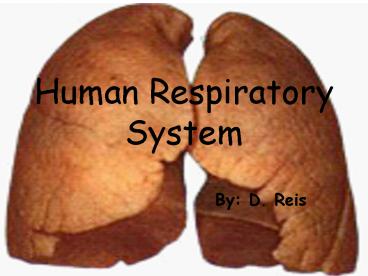Human Respiratory System PowerPoint PPT Presentation
1 / 14
Title: Human Respiratory System
1
Human Respiratory System
- By D. Reis
2
The Respiratory System
- Air enters the respiratory system through both
the nasal cavity and mouth. - The nasal cavity is lined with tiny hairs and
mucus to trap foreign particles. - The air is warmed and moistened.
3
Respiration and Gas Exchange
4
The Respiratory System
- Pharynx where the nasal cavity and oral cavity
meet - Epiglottis flap that closes over the top of the
trachea(glottis) due to reflexive action while
eating - Trachea the windpipe through which air passes
- Supported by cartilage rings
5
The Respiratory System
- Larynx voicebox located in the trachea
containing vocal cords. The vocal cords vibrate
producing sounds. - Adams Apple thick band of cartilage protecting
larynx.
6
The Respiratory System
- Bronchi extend from the trachea also contains
cartilage - Bronchioles the smallest passageways of the
respiratory tract - Alveoli tiny air sacs where gas exchange occurs
between the air and the blood
7
Alveoli
- Each lung is made up of 150 million alveoli.
- Capillaries surround each cluster of alveoli and
ensure - gas diffusion between the air and blood occurs.
- Oxygen moves from the air inside the lungs to the
alveoli while carbon dioxide moves from the
alveoli into the air inside the lungs. - Lipoprotein prevents alveoli from sticking
together
8
Goblet cells
- Goblet cells mucus secreting cells lining the
trachea, bronchi and bronchioles to trap foreign
particles. - Cilia - hair like structures that sweep the
foreign particles up towards the mouth
9
Thoracic Cavity
- External intercostal muscles muscles between
the ribs that raise the rib cage, increasing
volume and reducing air pressure in chest. - Diaphragm muscle that separates organs of the
chest from abdominal cavity.
10
- Pleural membrane thin fluid-filled membrane
surrounding lungs and inner wall of chest cavity
that reduces friction during inhalation.
11
The Movement of Air
- Air moves from an area of high pressure to an
area of low pressure. - Air will move into the lungs when the air
pressure inside the lungs is less than the air
pressure outside the body. - Air will move out of the lungs when the air
pressure inside the lungs is______ than the air
pressure outside the body.
12
Inspiration (Inhaling)
- The diaphragm contracts and moves down
- External intercostal muscles expand rib cage
upward and outward - Volume of thoracic cavity increases therefore air
pressure decreases. - Movement of air into the lungs.
13
Expiration (Exhaling)
- The diaphragm relaxes and moves up
- External intercostal muscles move rib cage inward
and downward. - Volume of thoracic cavity decreases therefore air
pressure increases. - Movement of air out of the lungs.
14
(No Transcript)

